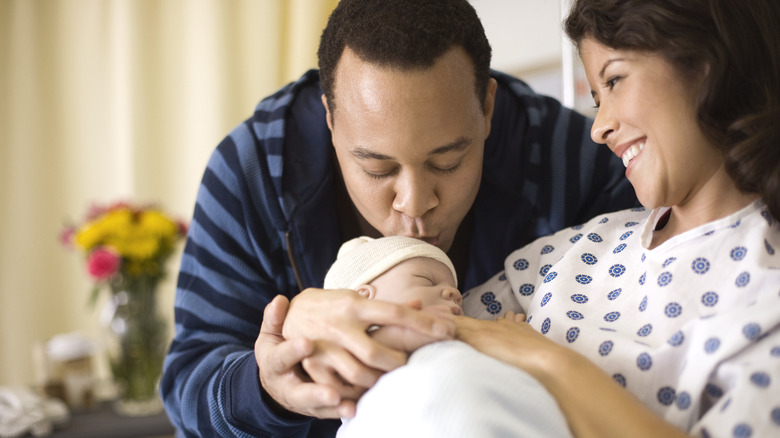How Your Period Changes After Giving Birth
The time has finally come that you get to meet your newborn baby and you're feeling over the moon. After giving birth, you bring your new family member home and begin to adjust to life with them in it as your body heals from the birthing experience. You may find yourself wondering when you will have your next official period and if you will experience any menstrual changes.
Prior to their period returning, women will experience postpartum bleeding called "lochia," according to the Cleveland Clinic. Lochia isn't a period, despite resembling one, and it generally lasts six weeks. It's made up of blood, mucus, and uterine tissue, and goes through three stages. "It's your body's way of cleaning you out," Erica Montes, M.D., an OB-GYN, told Parents. It's important not to use tampons during this time since the uterus is still healing from childbirth.
Your first period post-pregnancy can begin shortly after lochia ends. Breastfeeding mothers typically won't experience their first period until they transition their babies to solid foods, as the hormones that facilitate breastfeeding prevent ovulation. For mothers who aren't breastfeeding, their first period may occur within six to eight weeks after giving birth, as explained by Healthline.
New mothers may experience irregular periods and changes in flow after giving birth. However, it's important to note that each woman's experience with menstrual changes after childbirth can differ and may be influenced by factors like breastfeeding status and birth control.
Menstrual changes after giving birth
You may hope for your periods to go back to normal right away, but it may not be a cause for concern if your period looks and feels a little different after giving birth. "For women who are not breastfeeding, there are three things that are likely to happen with the menstrual period — periods return to normal, periods get worse or periods get better," Diane Young, M.D., an OB-GYN, explained to Cleveland Clinic.
One of the changes women can experience after giving birth is a heavier flow due to having an enlarged uterine cavity, according to BabyCenter. A 2017 study published in Medical Hypotheses also suggests that some women who have a cesarean section (C-section) birth may experience heavier menstrual bleeding and increased period pain after their delivery. Women who have recently given birth can also experience irregular periods, and it can take some time for their periods to go back to normal. For some mothers who are breastfeeding, it may take about a year for their menstrual cycle to stabilize.
Some women report having less menstrual pain after giving birth, as noted by UT Southwestern Medical Center. Additionally, it's not uncommon to see small blood clots during your first period following childbirth, but you should speak with your doctor if you're passing abnormally large blood clots that are the size of a plum.
Factors that can change your periods after childbirth
There are different variables that can contribute to changes to your period after pregnancy. As UT Southwestern Medical Center points out, irregular periods after giving birth can be a natural result of the hormonal changes the body experiences during pregnancy. Women who are breastfeeding produce less estrogen in their bodies during this time, making them especially prone to having irregular periods.
Certain medical conditions can also affect how your post-pregnancy periods look and feel. For example, women who have endometriosis may experience temporarily lighter periods following delivery because of greater amounts of progesterone in their body, according to the Cleveland Clinic. Taking birth control shortly after giving birth can also contribute to lighter, shorter, or absent periods.
Women with hyperthyroidism, hypothyroidism, or adenomyosis can experience difficult periods after pregnancy. Adenomyosis is a condition where endometrial tissue penetrates the uterine wall and breaks down during periods, as explained by the Beacon Health System. This abnormality can contribute to heavy flow and menstrual pain. It has been hypothesized that adenomyosis may result from childbirth and surgical procedures like cesarean sections (C-sections) and dilation and curettage (D&C) in some cases.



